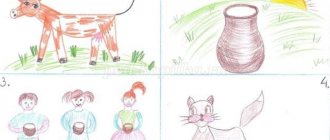November 09, 2016
Averyanova Sveta
The formation of graphic skills is necessary for the development of writing, drawing, and number drawing skills. Kindergarten teachers and parents use different exercises and tasks. One of the most effective and interesting techniques is graphic dictations.
Parents and teachers in “developmental” schools can dictate a simple drawing or instructions for the diagram, and children 5-6 years old are indescribably delighted with the results obtained. Let's talk about this method of preparing for school in more detail.
How to complete the task
- Print out the proposed tasks for children on A4 or A5 sheets.
- There is a red dot on each sheet - the graphic dictation will begin from this place.
- Explain to your child that 1 step is one cell. 2 steps - 2 cells, and so on. Each step occurs from one corner of the cell to the next in a given direction.
- It is necessary to clarify the concepts of “right”, “left”, “up”, “down” and “diagonally”.
- You can perform graphic dictation directly under dictation, or independently using the arrows at the top of each sheet.
- Great concentration and attentiveness are required, since even 1 mistake will lead to the drawing not working out. When used in classes at home with mother, mother's supervision is recommended.
Options for drawing by cells
Options for drawing by cells for children 6-7 years old can be divided into three groups:
- Drawing according to the proposed scheme, where the student must independently reproduce a similar drawing in his notebook.
- Drawing dictated by a parent or teacher. This task is performed by ear, and the adult indicates the direction of action - the number of cells up, down, right, left.
- Tasks without a drawn figure, but only with indication of the symbols by which the child himself draws. This is one of the most difficult options that is offered to older children. With this version of graphic dictation, the number of cells is indicated by a number, and the direction of movement is indicated by an arrow.
Quickly learn the multiplication tables for a preschool child
Continue the drawing by cells
In this type of task, children are presented with a symmetrical repeating pattern, which must be continued, for example, to the end of the line. The pattern can be of different levels of complexity, both the most elementary and more difficult. You can print such tasks on sheets of paper, or purchase special printed notebooks and put them in a math corner in the garden. Parents at home can come up with a pattern themselves by drawing it in a regular notebook, which the children will have to repeat.
An example of a simple checkered pattern
Symmetrical (mirror) drawing in cells
Mirror drawing in cells invites the child to complete part of the drawing, half of which has already been completed. But not just complete the drawing, but exactly as shown. The finished part can be located on the left or right, or maybe on top or bottom. The second option is more difficult. The child must strictly observe symmetry and draw the number of cells that was initially specified. These tasks are more difficult than others, but they perfectly develop abstract and logical thinking, perseverance and accuracy.
Print easy graphic dictations
To download the picture you like, click on it to enlarge. After that, save the image to your device. This way you can print out graphic dictations for free for personal use.
Graphic dictations by cells free download
Graphic dictations on a gray field in PDF format
Graphic dictations on a yellow field in PDF format
Print oral graphic dictations with answers
They try to make tasks for oral dictation a little simpler than those tasks that are done “from sight”, since they require more preparation and concentration. There are no diagonal lines in them. They are also provided with a picture answer to quickly show children an image of the correct solution.
If you find it difficult to unravel abstract images, here is a hint: the following are encrypted: sailboat, dragon, snowflake, bear, lion, car, chair, ladybug, hippopotamus, ship, octopus, hare, snowman, boat, turtle.
Dictations for independent work
These tasks, where the dictation field and the “path” with arrows are located next to each other, are convenient to use for independent work.
Explain to your child that movement along the arrows begins with a dot. The signs should be read from left to right horizontally .
Drawing according to instructions with arrows
This method differs from dictation by less control on the part of teachers. The child is given a piece of paper with a dot and a small instruction, usually in the form of arrows with the number of cells. The child draws a picture at his own pace.
You can conduct a workshop for beginners and young children to explain how the task is performed. This method perfectly trains perseverance and attentiveness in children.
Reverse task
If your child confidently and happily completes tasks in the cells under dictation and independently, offer him the task in reverse . You give a sample drawing, and the child encodes the movements of the pencil from the starting point: 2 up, 3 to the left, 1 down, 2 to the right, etc...
You don’t need to know how to write - the direction can be indicated with arrows. But knowing the numbers is a must!
To get started, you can use the pictures below, and then go even further: offer not only to encrypt the picture yourself, but first draw it on checkered paper!
Sketching
The child is given a completed drawing and a blank form. The child copies the picture by cells. You need to carefully monitor in which direction and how long the lines go.
It is important to interest the baby in drawing. For younger kids these should be simple templates. Boys may like cars or interesting geometric shapes, girls are happy to draw flowers and patterns.
If it’s difficult for a child...
If it is difficult for a child to complete tasks on cells with arrows, perhaps you have simply not yet worked out the meaning of the arrows, the concepts of “right, left, top, bottom.” Start with simple arrow exercises like these to get the vocabulary right.
Drawing by cells for children 5-7 years old
Drawing by cells is an effective tool for developing children's attentiveness. You can practice this format of activity from the age of five to six, gradually complicating the tasks. Most often, such graphic dictations are tasks in mathematics of the preparatory group “by cells” - one of the favorite activities of children. Thanks to it, children develop fine motor skills and spatial imagination. And all this is done in a playful way. Children, without noticing it themselves, learn something new and actively develop.
Graphic dictations
Such exercises are performed not only in kindergarten, but also in elementary school. This helps with the learning process and gives you some rest, especially when learning new, difficult topics.
Graphic dictations for school preparation
If the presented tasks did not seem enough to you, do not waste time searching for pictures in Yandex or Google.
Printing materials on various sites are often of poor quality, and there are errors in the dictation text, which completely kills the child’s desire to study further.
Here: print out assignments to prepare for school.
Ready-made manuals with graphic dictations are inexpensive and interesting . Here are examples.
Dictations from the book 5+ “Funny Cells. Graphic dictations. To prepare for school."
A very interesting set of tasks in Elena Uleva’s manual “Super developmental tasks for first graders. Graphic dictations for first graders"
Scans of tasks from the series “Waco. On the way to school. Graphic dictations"
Spreads of the notebook “Graphic dictations. Attention training. 1 class":
From the manual “Graphic dictations. From simple to the most complex. Guidelines for activities with children aged 5-7 years:











